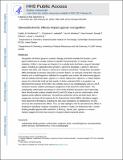Stereoelectronic Effects Impact Glycan Recognition
Author(s)
McMahon, Caitlin M; Isabella, Christine R; Windsor, Ian W; Kosma, Paul; Raines, Ronald T; Kiessling, Laura L; ... Show more Show less
DownloadAccepted version (1.356Mb)
Open Access Policy
Open Access Policy
Creative Commons Attribution-Noncommercial-Share Alike
Terms of use
Metadata
Show full item recordAbstract
Copyright © 2020 American Chemical Society. Recognition of distinct glycans is central to biology, and lectins mediate this function. Lectin glycan preferences are usually centered on specific monosaccharides. In contrast, human intelectin-1 (hItln-1, also known as Omentin-1) is a soluble lectin that binds a range of microbial sugars, including β-d-galactofuranose (β-Galf), d-glycerol 1-phosphate, d-glycero-d-talo-oct-2-ulosonic acid (KO), and 3-deoxy-d-manno-oct-2-ulosonic acid (KDO). Though these saccharides differ dramatically in structure, they share a common feature - an exocyclic vicinal diol. How and whether such a small fragment is sufficient for recognition was unclear. We tested several glycans with this epitope and found that l-glycero-α-d-manno-heptose and d-glycero-α-d-manno-heptose possess the critical diol motif yet bind weakly. To better understand hItln-1 recognition, we determined the structure of the hItln-1·KO complex using X-ray crystallography, and our 1.59 Å resolution structure enabled unambiguous assignment of the bound KO conformation. This carbohydrate conformation was present in >97% of the KDO/KO structures in the Protein Data Bank. Bioinformatic analysis revealed that KO and KDO adopt a common conformation, while heptoses prefer different conformers. The preferred conformers of KO and KDO favor hItln-1 engagement, but those of the heptoses do not. Natural bond orbital (NBO) calculations suggest these observed conformations, including the side chain orientations, are stabilized by not only steric but also stereoelectronic effects. Thus, our data highlight a role for stereoelectronic effects in dictating the specificity of glycan recognition by proteins. Finally, our finding that hItln-1 avoids binding prevalent glycans with a terminal 1,2-diol (e.g., N-acetyl-neuraminic acid and l-glycero-α-d-manno-heptose) suggests the lectin has evolved to recognize distinct bacterial species.
Date issued
2020Department
Massachusetts Institute of Technology. Department of ChemistryJournal
Journal of the American Chemical Society
Publisher
American Chemical Society (ACS)